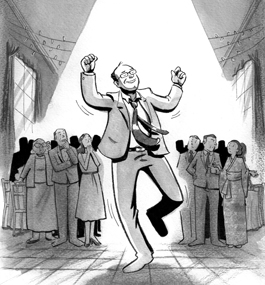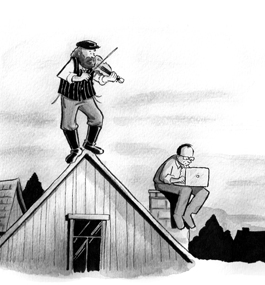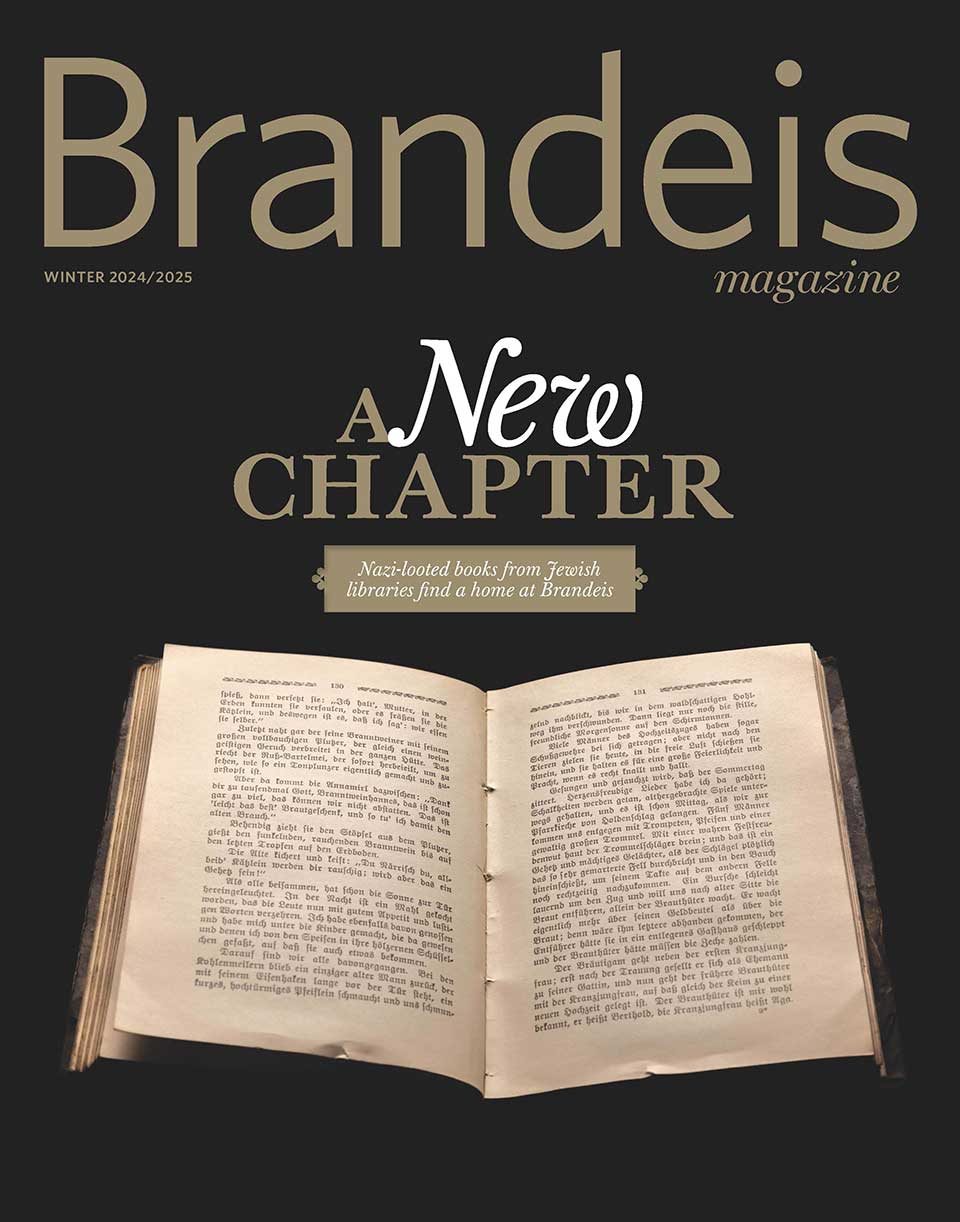A Fool in Yiddishland
After taking an Eastern European Jewry class at Brandeis, I realized I was a schmuck for not knowing more about my past.

Benjamin Schwartz
by Lawrence Goodman
Several years ago, I was asked to be a tummler at a Japanese wedding in New York. Tummler is Yiddish for a person “who makes a racket,” a jester, entertainer and emcee all rolled into one. My friend, David, the groom, is Jewish, but his family was outnumbered by the bride’s, who flew in from Japan for the ceremony. It was an awkward arrangement at best: His relatives were mainly from the Five Towns on Long Island, and hers were from Nakameguro. David hoped I might provide some social lubricant.
Getting over the language barrier was tough. I noticed the groom did not translate my “Take my wife … please” joke out of fear a guest would take it literally. David’s great-aunt told someone she would never forget where she was the day the Japanese attacked Pearl Harbor. One of the bride’s friends told me he was eager to learn about American Jews because they controlled the world’s money supply.
After a dinner of sushi, datemaki and daifuku, it was time for a hora. It fell to me to explain the traditional Israeli circle dance to the crowd. Executing the moves — holding hands and circling around ad nauseam — struck me as a lot easier to do than the group karaoke of “Smells Like Teen Spirit” performed at the rehearsal dinner the previous night.
I wanted to distill the hora tradition to its essence. “Could everyone repeat after me?” I said. “Chutzpah.”
All I got were murmurs and confused-looking faces.
“Now let’s try l’chaim.”
I was getting nowhere, and it didn’t help that at this moment the speaker system blared feedback. I was going to have to distill the essence down to its essence.
“Huch,” I said. “Everyone just say ‘huch.’”
The crowd voiced the universally recognized onomatopoeia for hocking a loogie.
Next, I fake-conjugated it. “Hecch.” “Hicch.” “Hocch.”
The crowd repeated the words after me. Everyone was laughing.
* * * * * *
In retrospect, this story says a lot about how little I knew about Yiddish. Jews spoke the language for hundreds of years while living in Eastern Europe. I’d reduced their experience to guttural sounds of phlegm clearing.
I knew Yiddish as a series of words and phrases my parents bandied about — yichus (pedigree), nachas (pride), tuchas (rear end) and alter cocker (old fart).
At Hebrew school, we learned about the Bible and modern-day Israel, skipping over Eastern Europe. I’ve forgotten everything I learned at Hebrew school, but if I hadn’t, I would say I was done a terrible disservice.
Last fall, I took the class “Yiddish Culture in the Modern World” at Brandeis alongside half a dozen undergraduate and graduate students. Taught by Ellen Kellman, assistant professor of Yiddish, the class was conducted as a seminar, with lots of discussion and provocative questions. Every now and then, Kellman livened things up by bringing in a music recording and letting us sing along.
Covering the mid-1800s to today, the course explored such topics as shtetl life, literature and theater, assimilation in America, and the revival of klezmer. To Kellman’s great credit, we didn’t spend a lot of time on the Holocaust. This was Eastern European Jewry on its own terms, not nostalgized, mourned or distorted by anger over the Nazi horror. We were not going to reduce the Jews in Russia, Poland, Lithuania and elsewhere to mere martyrs.
At its height, Yiddish was spoken by several million Jews living in Russia and neighboring countries. It’s a synthesis of German, Hebrew and, to a lesser extent, Slavic languages. Sentences lilt upward at the end so that statements sound like questions, begetting more questions, until the whole thing has to be settled by the rabbi.
There’s no agreed-upon definition of shtetl, a small town or village where Jews lived in Eastern Europe. I discovered shtetls weren’t the isolated, insular places I’d always envisioned. Gentiles lived there and intermingled with Jews. In addition to a temple, a marketplace, a school and a cemetery, shtetls usually included a church.
Nor was life so bad there, another surprise to me. Pogroms — anti-Jewish riots — were actually rare until the late 19th century. Jews found gainful employment as horse traders, purveyors of alcohol, shopkeepers, carpenters and shoemakers.

Benjamin Schwartz
page 2 of 2
The scholar John Klier argues Jews emigrated to America not to flee oppression, which is what I always thought, but because of overpopulation and a lack of economic opportunity. Between 1800 and 1900, the number of Russian Jews skyrocketed from 1 million to 5 million. There weren’t enough jobs or plots of land to go around. Evidently, everyone kept busy by shtupping.
Yiddish was more than a language. It was a Weltanschauung — a worldview. It gave rise to great writers: I.L. Peretz, S. Ansky and, of course, Sholom Aleichem. It was the parlance of intellectual movements such as Zionism, socialism and Haskalah, a reformist effort to bring Enlightenment values to the shtetl.
In the late 1800s, when Israel still seemed an impossible dream to many, Jewish intellectuals advocated establishing an entire nation based on their mother tongue, a kind of Yiddishland where a secular culture and politics rooted in the Eastern European Jewish experience could thrive. It didn’t much matter where it was founded. “In the tropical heat of Africa and in Rio de Janeiro / In Mexico, in Cuba and Canada — / Yiddish ... makes the rockiest soil bear fruit,” the poet A. Almi believed.
* * * * * *
We wrote three papers for the class. My last focused on “Fiddler on the Roof.” Along with the story of Exodus told on Passover, the 1964 musical is the foundational myth of American Judaism. Everyone loves “Fiddler.” As any theater producer not in a flyover state will tell you, you can’t revive it enough.
It’s based, with significant alterations, on “Tevye the Dairyman,” a story collection by Sholom Aleichem. Literary critic Ruth Wisse says the play, unlike the stories, proselytizes for conversion. In Aleichem’s original, Tevye’s daughter leaves her gentile husband, repents and never obtains her father’s forgiveness.
In another major departure from the Aleichem stories, at the end of “Fiddler” Tevye and his family leave for America. The original Tevye goes nowhere. His attempts to travel to Palestine, like most things in his life, don’t work out, and he remains stuck in Ukraine. “How lucky I was to be born a Jew and know the taste of exile and of always wandering, never sleeping where we spent the day,” Tevye says sarcastically in the final story. “Our old God lives!” he adds later.
“Fiddler” is the primary way most of us learn about Eastern European Jewry. It bathes that time in nostalgia, wistfully evoking a bygone world but offering the consolation that its customs and traditions are probably ones we’re better-off without. Begrudging as he may be, the Tevye in “Fiddler” accepts the changes taking place all around him. He’s a schlemiel and a wise man because he knows love is more important than upholding traditions, even if it means enduring the ultimate shonda (shame) of having your daughter marry a goy.
The musical offers up hundreds of years of Jewish life in Eastern Europe as a prelude to life in the new promised land of America. Aleichem’s original stories, on the other hand, articulate the existential plight of a people living in permanent exile. Tevye is Job, transplanted to Aleichem’s fictional town, Boyberik. He wrestles with a God who is mercurial and unknowable, who demands love but doesn’t return it.
The bittersweet ending of “Fiddler” brings tears to the eyes but also the consolation of knowing Tevye is off to a better life in the United States. Aleichem sends a different message: We’re screwed.
At my friend’s wedding, my loogie-hocking gambit for breaking down the cultural divide worked. When the first wails of the klezmer sounded, everyone took to the dance floor for the hora, and I believed I, like a Jewish Marco Polo, had brought a bit of Yiddishkeit to the Japanese.
But I regret my shtik now. I didn’t do my heritage justice. As my ancestors would have said, “Via veyst a khazer fun lokshn?” What could a pig possibly know about noodles?
